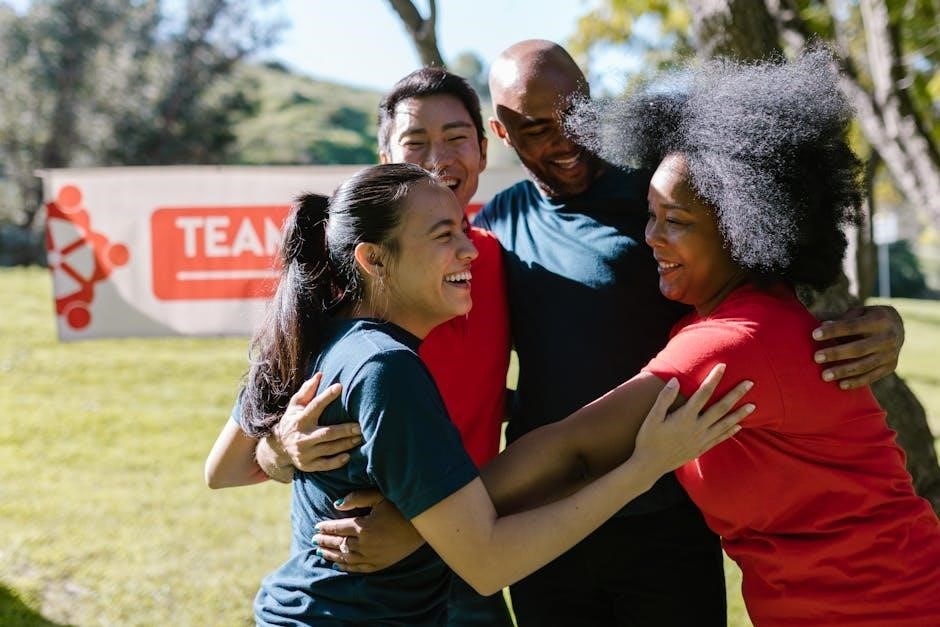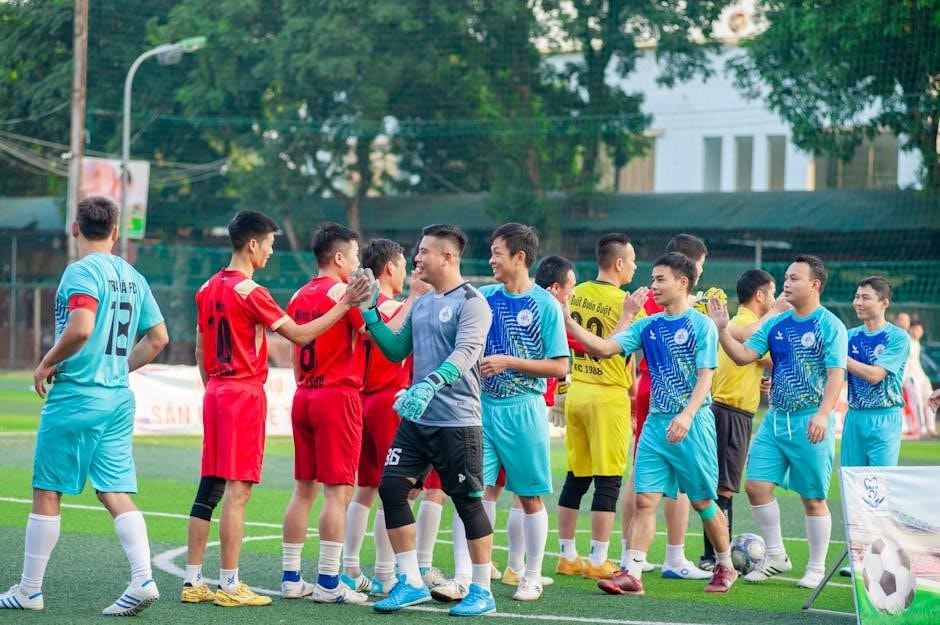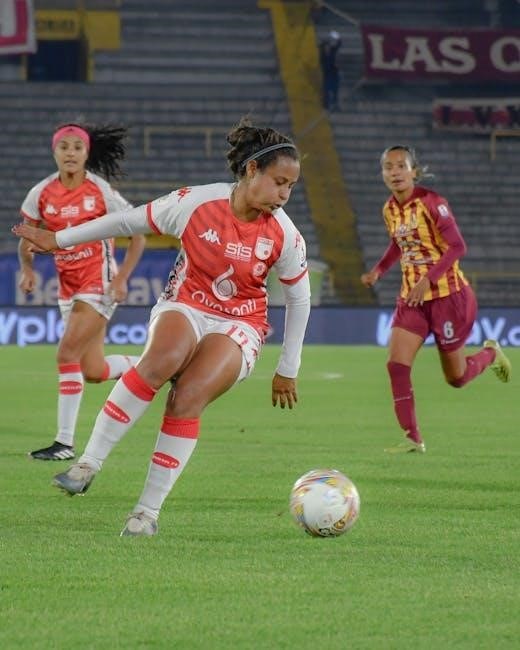group dynamics for teams 6th edition pdf
Explore the essentials of teamwork with Group Dynamics for Teams, 6th Edition by Daniel Levi and David A. Askay. This guide provides a comprehensive overview of group behavior, focusing on collaboration, communication, and leadership. It offers insights into enhancing team performance and understanding the psychological aspects of group dynamics. Ideal for both students and professionals seeking to improve teamwork effectiveness in various organizational settings.
Discover how to foster cooperation, manage conflicts, and build trust within teams through evidence-based strategies and real-world applications.
1.1 What is Group Dynamics?
Group dynamics refers to the study of how individuals interact and behave within groups, focusing on the psychological processes that influence group behavior and performance. It examines how teams form, develop, and function, emphasizing factors like goals, norms, cooperation, and communication. Understanding group dynamics helps identify how cohesion, trust, and conflict resolution shape team outcomes. This concept is central to improving teamwork and organizational effectiveness, as explored in Group Dynamics for Teams, 6th Edition, which provides insights into enhancing collaboration and leadership in various settings.
1.2 The Importance of Group Dynamics in Teamwork
Group dynamics play a crucial role in teamwork by shaping how individuals collaborate, communicate, and resolve conflicts. Understanding these dynamics enhances trust, cohesion, and collective problem-solving, leading to more effective team outcomes. By addressing factors like goals, norms, and cooperation, teams can align their efforts and achieve shared objectives. The insights from Group Dynamics for Teams, 6th Edition emphasize how fostering positive interactions and addressing challenges can significantly improve teamwork and organizational success. This knowledge is essential for building high-performing teams in diverse workplace settings.
1.3 Overview of the 6th Edition
The 6th edition of Group Dynamics for Teams, authored by Daniel Levi and David A. Askay, offers an updated exploration of group behavior and teamwork principles. Published by SAGE Publications, this edition incorporates the latest research, focusing on essential concepts like goals, norms, and communication. It provides practical strategies for enhancing collaboration and addressing workplace challenges. The collaboration between Levi and Askay brings a fresh perspective, blending psychological insights with real-world applications. This edition is a valuable resource for understanding and improving team dynamics in various organizational contexts.

Key Concepts in Group Dynamics

Discover the core principles shaping team behavior, including goals, norms, cooperation, and communication. These elements form the foundation of effective collaboration and teamwork, essential for understanding group dynamics.
2.1 Goals and Motivation in Teams
Understanding how goals and motivation drive team performance is crucial. Clear, shared objectives align team efforts, fostering a sense of purpose and direction. Motivation theories, such as goal-setting and self-efficacy, explain how individuals within teams are driven to achieve. Leaders play a key role in setting realistic goals and inspiring team members. When team goals are aligned with organizational objectives, motivation increases, leading to higher productivity and satisfaction. Effective goal-setting and motivation strategies are essential for building cohesive and high-performing teams, as emphasized in the 6th Edition of Group Dynamics for Teams.
2.2 Norms and Standards in Group Behavior
Group norms and standards are the unwritten rules that guide behavior within teams, influencing how members interact and perform. Norms develop naturally over time, reflecting shared values and expectations. They can enhance team cohesion but may also lead to conformity. Standards, on the other hand, set benchmarks for performance and quality. Both norms and standards are shaped by leadership, communication, and organizational culture. Understanding these dynamics is key to fostering positive group behavior, as discussed in the 6th Edition of Group Dynamics for Teams by Daniel Levi and David A. Askay. Effective management of norms and standards can significantly improve team outcomes.
2.3 Cooperation and Collaboration
Cooperation and collaboration are essential for achieving shared goals in teams. Cooperation involves working together willingly, while collaboration emphasizes shared responsibility and active participation. Both are vital for fostering innovation and problem-solving. In the 6th Edition of Group Dynamics for Teams, Daniel Levi and David A. Askay highlight how these elements enhance team performance. Effective cooperation and collaboration require clear communication, mutual respect, and a collective commitment to success. By aligning individual efforts with team objectives, members can create a synergistic environment that drives productivity and satisfaction. These principles are fundamental to building high-performing teams in any organizational setting.
2.4 Communication in Group Settings

Effective communication is the backbone of successful group dynamics, enabling teams to share ideas, coordinate efforts, and resolve conflicts. In Group Dynamics for Teams, 6th Edition, Daniel Levi and David A. Askay emphasize the importance of both verbal and non-verbal communication. Clear and concise messaging fosters understanding, while active listening ensures all voices are heard. Miscommunication can hinder collaboration, making it crucial to establish open and transparent dialogue. The authors provide practical strategies for improving communication, such as clarifying roles and using feedback to enhance team interactions. Strong communication skills are essential for building trust and achieving shared goals.
2.5 Trust and Cohesion in Teams
Trust and cohesion are essential for fostering a positive and productive team environment. In Group Dynamics for Teams, 6th Edition, Daniel Levi and David A. Askay highlight how trust builds a foundation for open communication and collaboration. Cohesion strengthens team unity, enabling members to work seamlessly toward shared goals. High levels of trust and cohesion reduce conflicts and enhance problem-solving capabilities. The authors provide insights into strategies for cultivating trust, such as promoting transparency and accountability, and fostering a sense of belonging. Strong trust and cohesion are critical for achieving long-term team success and satisfaction.
These elements are vital for creating resilient and high-performing teams.

The Role of Leadership in Group Dynamics
Leadership plays a pivotal role in shaping team dynamics. In Group Dynamics for Teams, 6th Edition, Daniel Levi and David A. Askay explore how leaders influence motivation, direction, and cohesion. Effective leadership fosters collaboration, resolves conflicts, and aligns team goals with organizational objectives. The authors emphasize the importance of adaptive leadership styles to enhance team performance and satisfaction.
Strong leadership is essential for guiding teams through challenges and achieving success.
3.1 Leadership Styles and Their Impact on Teams
In Group Dynamics for Teams, 6th Edition, Daniel Levi and David A. Askay examine how different leadership styles shape team behavior. Transformational leaders inspire and motivate, fostering creativity and commitment, while transactional leaders focus on task completion through clear roles and rewards. Laissez-faire leaders delegate authority, empowering team members but risking ambiguity. Each style has unique effects on collaboration, decision-making, and trust. The authors highlight the importance of adapting leadership styles to team needs and contexts. Effective leaders balance direction, support, and flexibility to optimize team performance and satisfaction.
Understanding these dynamics is crucial for developing successful leadership strategies.
3.2 Effective Leadership Strategies for Team Success
In Group Dynamics for Teams, 6th Edition, Daniel Levi and David A. Askay outline proven strategies for leadership effectiveness. Clear communication, goal-setting, and empowering team members are emphasized. Leaders should foster a positive team culture, encourage collaboration, and provide constructive feedback. Recognizing contributions and promoting inclusivity enhances morale and engagement. Adapting strategies to team needs ensures alignment with organizational objectives. These approaches, supported by real-world examples, help leaders cultivate high-performing teams and drive success in dynamic environments.
Practical insights enable leaders to navigate challenges and optimize team potential effectively.

3.3 The Influence of Leadership on Group Norms
Leadership significantly shapes group norms by setting the tone for acceptable behavior and attitudes. In Group Dynamics for Teams, 6th Edition, Levi and Askay explain how leaders influence norms through their actions, decisions, and communication. Effective leaders model desired behaviors, fostering a positive team culture. They establish expectations and encourage adherence to shared standards. Leaders also play a role in addressing and modifying negative norms to promote productivity and cohesion. Their influence ensures that group norms align with organizational goals, creating a productive and collaborative team environment.
This alignment is crucial for sustaining high-performance teams.
Communication Strategies for Effective Group Dynamics
Effective communication is vital for teamwork, fostering collaboration and resolving conflicts. Verbal and non-verbal cues, active listening, and clear feedback enhance understanding and alignment with team goals.
4.1 Verbal and Non-Verbal Communication in Teams
Effective communication in teams relies on both verbal and non-verbal cues. Verbal communication involves clear and concise language, while non-verbal cues, such as body language and facial expressions, convey emotions and intentions. In Group Dynamics for Teams, 6th Edition, Daniel Levi and David A. Askay emphasize the importance of aligning verbal messages with non-verbal signals to avoid misunderstandings. Non-verbal cues can enhance trust and engagement, while verbal communication ensures clarity and precision. Understanding both aspects is crucial for fostering collaboration and resolving conflicts effectively in team settings.
4.2 Active Listening and Feedback in Group Settings
Active listening and constructive feedback are vital for effective communication in teams. In Group Dynamics for Teams, 6th Edition, Daniel Levi and David A. Askay highlight the importance of actively engaging with others’ perspectives. Active listening involves fully focusing on the speaker, understanding their message, and showing empathy. Providing timely and specific feedback helps team members grow and improves collaboration. Both practices foster trust, clarity, and mutual respect, enabling teams to address challenges and achieve shared goals more effectively. Regular feedback loops ensure continuous improvement and strengthen team cohesion.
4.3 Conflict Resolution Through Communication
Effective communication is key to resolving conflicts in teams. In Group Dynamics for Teams, 6th Edition, strategies for addressing disagreements through open dialogue are explored. Active listening and clarity in expressing concerns help prevent misunderstandings. Constructive feedback and respectful exchanges foster collaboration, enabling teams to find solutions that benefit everyone. By promoting transparent communication, teams can transform conflicts into opportunities for growth and strengthened relationships. This approach ensures that conflicts are resolved in a way that enhances trust and maintains a positive team dynamic.
Conflict Resolution in Group Dynamics
Conflict resolution is crucial for maintaining harmony and productivity in teams. The 6th Edition explores strategies to address disagreements, fostering understanding and collaboration to achieve positive outcomes.
5.1 Understanding Conflict in Teams
Conflict in teams arises from differing opinions, values, or goals among members. It can stem from communication breakdowns, role ambiguities, or competing priorities. While conflict can foster innovation and creativity, it can also hinder productivity and morale if not managed effectively. The 6th Edition emphasizes understanding the root causes of conflict, such as emotional responses and power imbalances, to address it constructively. Recognizing these dynamics is the first step toward resolving disputes and maintaining team cohesion. Early identification and intervention are crucial to prevent escalation and promote a positive team environment.
5.2 Strategies for Managing Conflict
Effective conflict management in teams involves fostering open communication, active listening, and collaborative problem-solving. Encourage team members to express their perspectives respectfully and avoid assumptions. Leaders should mediate disputes impartially, focusing on shared goals. Techniques like compromise and negotiation can resolve disagreements without harming relationships. Addressing conflicts promptly prevents escalation and strengthens trust. Promoting a culture of constructive dialogue and mutual respect ensures that conflicts become opportunities for growth rather than obstacles. The 6th Edition highlights these strategies to enhance teamwork and maintain a productive, cohesive environment.
Proactive approaches to conflict resolution are essential for long-term team success.
5.3 The Role of Communication in Conflict Resolution
Effective communication is vital for resolving conflicts within teams. It involves active listening, clarity in expression, and empathy to understand differing perspectives. Open dialogue helps identify underlying issues and fosters mutual understanding. The 6th Edition emphasizes the importance of non-verbal cues and tone, which can significantly impact conflict resolution. Encouraging constructive feedback and maintaining a respectful tone prevents escalation. By promoting transparent and honest communication, teams can address disputes collaboratively, leading to stronger relationships and more cohesive outcomes.
Clear communication strategies are essential for turning conflicts into opportunities for growth and improved teamwork.
Decision-Making Processes in Groups
Group decision-making involves balancing diverse perspectives to achieve consensus. The 6th Edition examines models that enhance collaboration, avoid pitfalls like groupthink, and improve decision quality for organizational success.
6.1 Group Decision-Making Models
Group decision-making models provide structured approaches for teams to reach consensus. The 6th Edition explores models like consensus, majority vote, and authoritarian decision-making, highlighting their pros and cons. These frameworks help teams navigate complex choices, ensuring inclusivity and efficiency. Effective models balance individual inputs with collective goals, fostering collaboration and reducing conflicts. By understanding these approaches, teams can tailor decision-making processes to their specific needs, enhancing overall performance and accountability. Levi and Askay emphasize the importance of aligning models with team dynamics to achieve optimal outcomes in organizational settings.
6.2 The Impact of Groupthink on Decision Quality
Groupthink significantly undermines decision quality by prioritizing consensus over critical thinking. In Group Dynamics for Teams, 6th Edition, Levi and Askay explain how groupthink leads to irrational decisions, as teams ignore alternative perspectives and risks. This phenomenon often results in poor outcomes, as dissenting voices are suppressed. The authors emphasize the importance of fostering diverse viewpoints and encouraging constructive conflict to mitigate groupthink. By promoting a culture of open communication and critical evaluation, teams can enhance decision-making accuracy and avoid the pitfalls of groupthink, ultimately achieving more effective and well-rounded solutions in organizational settings.
6.3 Techniques for Improving Group Decisions
Effective decision-making in teams requires structured approaches to enhance collaboration and critical thinking. In Group Dynamics for Teams, 6th Edition, Levi and Askay highlight techniques such as brainstorming, devil’s advocacy, and the nominal group technique to foster diverse perspectives. These methods encourage team members to voice unique ideas, reducing the risk of groupthink and improving decision quality. Additionally, establishing clear goals and using decision-making models can streamline processes. By implementing these strategies, teams can make more informed, balanced, and effective decisions, ensuring better outcomes in organizational settings while fostering a culture of constructive collaboration.
The Role of Group Dynamics in Organizational Behavior
Influence organizational behavior through group dynamics, fostering a positive culture and enhancing team performance. Key concepts like norms and collaboration shape workplace interactions and overall effectiveness.
7.1 Understanding Organizational Behavior Through Group Dynamics
Group dynamics provides a framework to understand organizational behavior by analyzing how individuals interact within teams. Key concepts like norms, collaboration, and communication shape workplace culture and performance. By studying group behavior, organizations can identify patterns that influence productivity, morale, and decision-making. Leadership styles and conflict resolution also play a crucial role in fostering a positive organizational environment. The insights from Group Dynamics for Teams, 6th Edition help professionals align team goals with organizational objectives, promoting a cohesive and effective workplace. This understanding is vital for addressing challenges and enhancing overall organizational success.
7.2 The Impact of Group Norms on Organizational Culture
Group norms significantly influence organizational culture by shaping shared beliefs and behaviors within teams. These norms, whether explicit or implicit, determine how employees interact, make decisions, and align with organizational values. Positive norms can foster innovation, collaboration, and accountability, while negative norms may lead to resistance to change or unethical practices. As highlighted in Group Dynamics for Teams, 6th Edition, understanding and managing group norms is crucial for cultivating a positive organizational culture that supports teamwork and long-term success. Effective leadership plays a key role in guiding these norms to align with organizational goals.
7.3 Enhancing Organizational Performance Through Effective Teamwork
Effective teamwork is a cornerstone of organizational success, driving innovation, productivity, and employee satisfaction. By fostering collaboration, communication, and trust, teams can align their efforts with organizational goals, enhancing overall performance. Group Dynamics for Teams, 6th Edition emphasizes the importance of clear roles, shared responsibilities, and collective accountability. When teams function cohesively, they solve problems more efficiently and adapt to change, ultimately contributing to the organization’s competitive edge. Investing in teamwork development ensures a stronger, more resilient workforce capable of achieving strategic objectives.

Challenges in Managing Group Dynamics
Managing group dynamics involves navigating conflicts, diversity, and communication barriers. Challenges include resolving disagreements, fostering inclusion, and ensuring active participation. Addressing these issues is crucial for productivity and collaboration, requiring effective strategies to overcome obstacles and maintain harmony within teams.
8.1 Common Challenges in Team Collaboration
Effective team collaboration often faces challenges such as differing opinions, communication gaps, and conflicting priorities. Power struggles and dominance by certain members can hinder progress. Additionally, technological barriers, such as inadequate tools or remote work challenges, can disrupt coordination. Procrastination and inconsistent work ethic among team members may also impede productivity. Addressing these issues requires strong leadership, open dialogue, and adaptive strategies to ensure alignment and shared goals. Overcoming these obstacles is essential for fostering a cohesive and productive team environment.
8.2 Managing Diversity and Inclusion in Teams
Managing diversity and inclusion in teams is crucial for fostering creativity and innovation. Diverse teams bring varied perspectives, but differences can lead to misunderstandings. Challenges include biases, cultural gaps, and unequal participation. Leaders must promote inclusivity by encouraging open communication and active listening. Strategies like diversity training, clear expectations, and addressing microaggressions can help. Inclusive teams thrive when all members feel valued and empowered to contribute. Daniel Levi and David A. Askay emphasize creating safe spaces for dialogue to enhance collaboration and mutual respect, ensuring diversity becomes a team strength rather than a barrier.
8.3 Overcoming Barriers to Effective Communication
Effective communication is vital for team success, but barriers like language differences, cultural misunderstandings, and emotional conflicts often arise. To overcome these, teams must foster open dialogue and active listening. Leaders should encourage clarity in messaging and provide feedback mechanisms. Daniel Levi and David A. Askay highlight the importance of addressing physical and emotional barriers, such as distractions or fear of judgment. Creating a positive communication climate where members feel safe to express ideas is key. Regular feedback and continuous improvement strategies can enhance understanding and collaboration, ensuring seamless communication flows within the team.
Best Practices for Effective Group Dynamics
Implement strategies like fostering trust, encouraging participation, and promoting inclusivity. Group Dynamics for Teams, 6th Edition emphasizes collaboration, clear communication, and aligning team goals with organizational objectives for success.
9.1 Building Trust and Cohesion in Teams
Building trust and cohesion in teams is essential for effective collaboration. Group Dynamics for Teams, 6th Edition highlights the importance of transparency, accountability, and open communication to foster trust. Encourage team members to share ideas and perspectives, promoting psychological safety. Leaders should model trustworthy behavior and create opportunities for team bonding. Cohesion can be strengthened through shared goals, mutual respect, and celebrating successes. High levels of trust and cohesion lead to improved collaboration, increased morale, and enhanced team performance, making them critical components of successful group dynamics.
9.2 Encouraging Active Participation and Engagement
Encouraging active participation and engagement is vital for team success. Group Dynamics for Teams, 6th Edition emphasizes the importance of fostering an inclusive environment where all members feel valued. Leaders should promote open dialogue, encourage diverse perspectives, and create opportunities for meaningful contributions. Active listening and positive feedback can motivate team members to engage fully. Additionally, setting clear expectations and empowering individuals to take ownership of tasks can enhance participation. When teams are actively engaged, collaboration flourishes, leading to innovative solutions and improved overall performance. This fosters a culture of shared responsibility and collective success.
9.3 Fostering a Positive Team Culture
Fostering a positive team culture is essential for long-term success; Group Dynamics for Teams, 6th Edition highlights the importance of trust, inclusivity, and shared values. Leaders should encourage open communication and recognize contributions to build morale. Creating a culture of appreciation and respect motivates team members to collaborate effectively. By promoting a supportive environment, teams can align their goals with organizational objectives, leading to increased commitment and productivity. A positive culture not only enhances teamwork but also fosters innovation and resilience, ensuring teams thrive in dynamic environments.

The Authors’ Contributions to Group Dynamics
Daniel Levi and David A. Askay’s collaborative work in the 6th edition offers deep insights into team behavior and leadership, enhancing understanding of group dynamics.
10.1 Daniel Levi’s Research and Insights
Daniel Levi, a professor in the Psychology and Child Development Department at Cal Poly, has significantly contributed to understanding group dynamics. His research focuses on team behavior, technological change, and organizational improvement. Levi’s work emphasizes the practical application of psychological concepts to enhance team performance. In the 6th edition of Group Dynamics for Teams, co-authored with David A. Askay, Levi provides insights into collaboration, communication, and leadership. His expertise bridges theory and practice, offering valuable strategies for improving teamwork in various organizational settings. His contributions remain foundational in the field of group dynamics and organizational behavior.
10.2 David A. Askay’s Contributions to the Field

David A. Askay, co-author of the 6th Edition of Group Dynamics for Teams, brings fresh insights to the field, complementing Daniel Levi’s foundational work. His contributions focus on enhancing collaboration, communication, and leadership within teams. Askay’s expertise lies in applying psychological principles to real-world organizational challenges, offering practical strategies for improving teamwork. Through his research and collaboration, he emphasizes the importance of trust, cohesion, and effective decision-making in group settings. His work has significantly enriched the understanding of group dynamics, making him a valuable contributor to this essential guide for teams.
10.3 The Collaboration Between Levi and Askay
The collaboration between Daniel Levi and David A. Askay in the 6th Edition of Group Dynamics for Teams marks a significant advancement in the field. Combining Levi’s extensive research on teamwork and organizational behavior with Askay’s expertise in communication and collaboration, their partnership provides a comprehensive understanding of group dynamics. Their joint effort integrates theoretical insights with practical applications, offering readers a well-rounded approach to enhancing team performance. This collaboration enriches the text, making it a valuable resource for both academic and professional settings.

The Future of Group Dynamics in Teams
The future of group dynamics will be shaped by emerging technologies, virtual collaboration tools, and evolving leadership styles, fostering innovation and enhancing team productivity in modern workplaces.
11.1 Emerging Trends in Team Collaboration
Emerging trends in team collaboration highlight the integration of technology, such as AI-driven tools and virtual platforms, to enhance communication and productivity. Remote work has accelerated the adoption of digital collaboration software, enabling seamless teamwork across geographical boundaries. The sixth edition emphasizes the growing importance of adaptability and innovation in team dynamics. These trends are reshaping how teams interact, making collaboration more efficient and inclusive. By leveraging these advancements, teams can achieve higher levels of performance and responsiveness in an ever-evolving workplace landscape.
11.2 The Role of Technology in Shaping Group Dynamics
Technology has profoundly influenced group dynamics, enhancing communication and collaboration through virtual tools and platforms. The 6th edition highlights how digital advancements, such as AI-driven software and cloud-based solutions, streamline teamwork. Tools like Slack and Microsoft Teams foster real-time interaction, enabling remote teams to function seamlessly. However, technology also introduces challenges, such as information overload and reduced face-to-face engagement. Effective integration of technology requires balancing efficiency with interpersonal trust and cohesion. This balance is critical for leveraging technological advancements to improve team performance and adaptability in a rapidly changing work environment.
11.3 The Evolution of Leadership in Modern Teams
Leadership in modern teams has evolved significantly, shifting from hierarchical structures to more collaborative and adaptive approaches. The 6th edition emphasizes the importance of transformational and servant leadership styles, which foster empowerment and shared decision-making. Technology has also redefined leadership roles, with virtual tools enabling remote team management and communication. Leaders now prioritize emotional intelligence, inclusivity, and agility to navigate dynamic environments. This evolution ensures that leadership remains effective in fostering trust, innovation, and high-performance teams, aligning with the demands of a rapidly changing workplace.